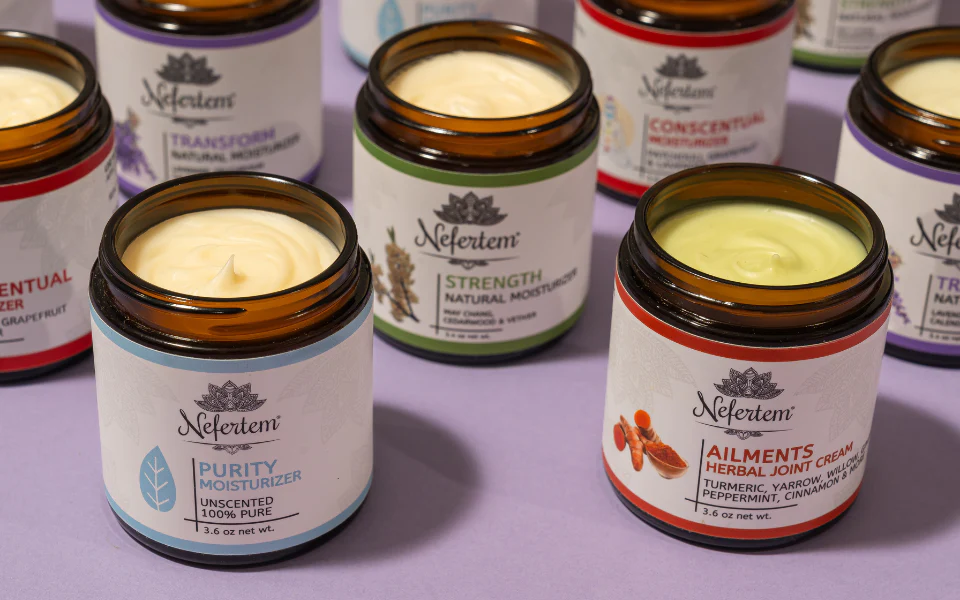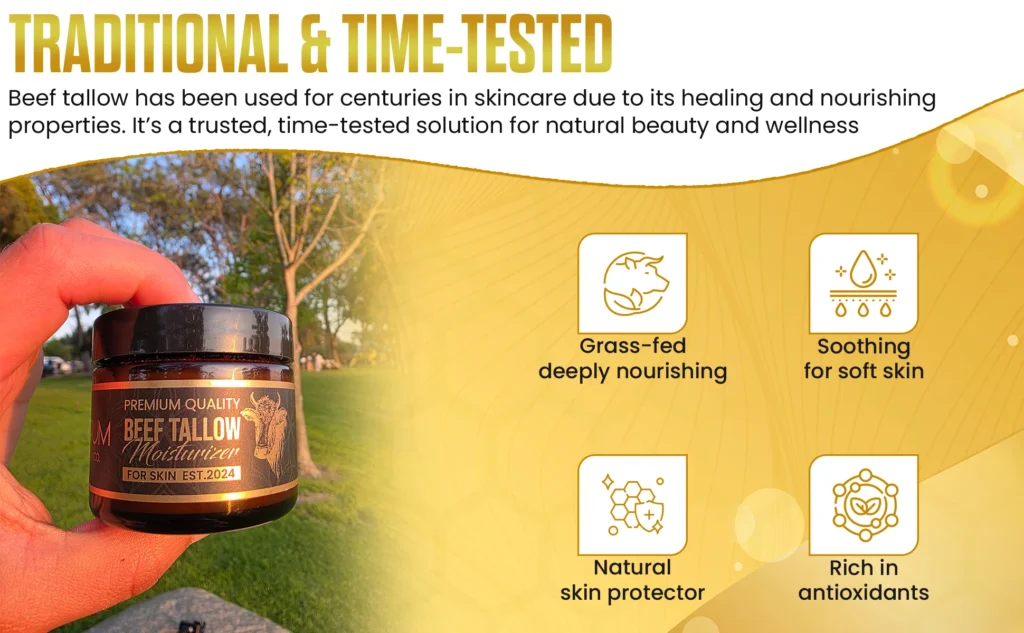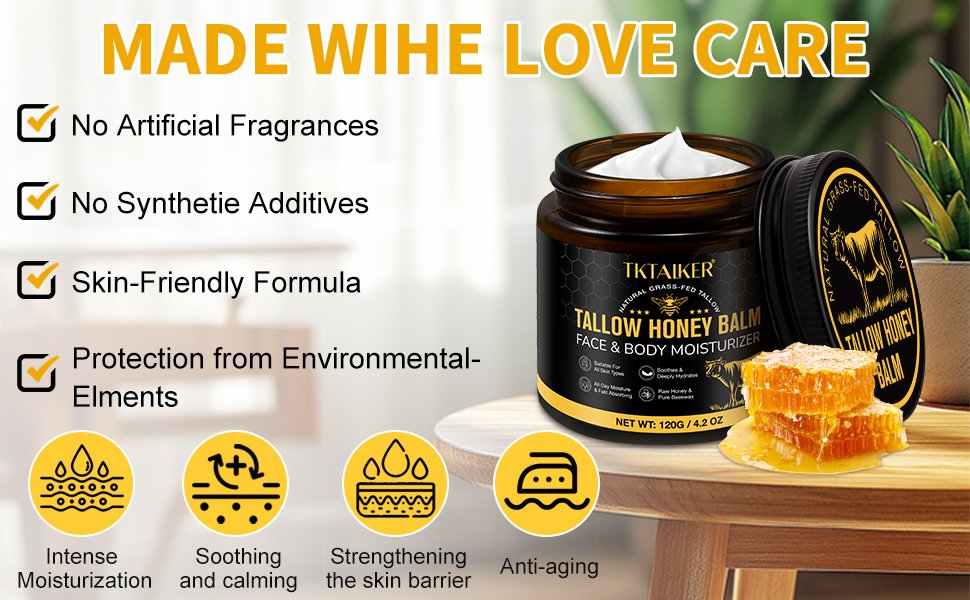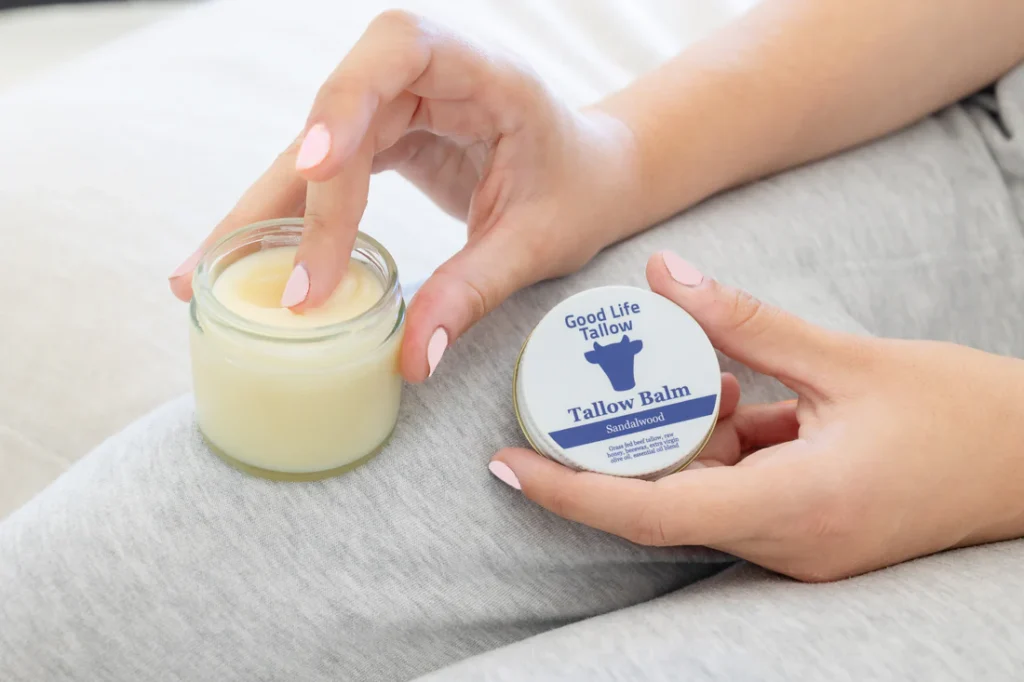Introduction
Natural skincare has taken the beauty world by storm, and one of the most talked-about ingredients today is beef tallow. Once used in traditional remedies, this rendered animal fat is making a comeback as a deeply nourishing moisturizer. Advocates claim that beef tallow restores skin balance, repairs dryness, and offers anti-aging benefits — all thanks to its similarity to the natural oils in human skin. However, not everyone agrees. Some dermatologists warn that it can clog pores or cause irritation, especially for sensitive skin types.
This detailed guide explores what beef tallow really does for your skin, how it compares to modern skincare products, and how to use it safely if you decide to try it. Based on evidence, expert opinions, and user experiences, we’ll separate the truth from the hype so you can make an informed skincare decision.

What Is Beef Tallow?
Beef tallow is a purified form of animal fat that’s been rendered — meaning it’s slowly melted down, filtered, and cooled into a creamy solid. It has been used for centuries in cooking, candle making, soap production, and skincare. Because it’s high in saturated and monounsaturated fats, beef tallow stays stable at room temperature and offers a texture similar to thick butter or balm.
Tallow contains essential fatty acids and fat-soluble vitamins such as A, D, E, and K, all of which support skin health. Its composition is remarkably similar to human sebum — the natural oil our skin produces. This similarity allows beef tallow to absorb easily and strengthen the skin’s barrier, making it an excellent moisturizer for dry, chapped, or mature skin when used correctly.
However, not all tallow is equal. For skincare use, it’s best to choose grass-fed, high-quality, and purified tallow free from additives or synthetic fragrances.
Key Benefits of Beef Tallow for Skin
1. Deep Moisturization
Beef tallow provides intense hydration by forming a protective layer over the skin that prevents moisture loss. This helps soothe dry or flaky skin, especially during winter months. Unlike synthetic moisturizers that sit on the surface, tallow penetrates deeper due to its compatibility with the skin’s natural lipids.
2. Skin Barrier Repair
The fatty acids in tallow, such as stearic and palmitic acid, are essential for rebuilding and maintaining the skin’s barrier. Regular use can help improve the skin’s resilience, reducing sensitivity and redness over time.
3. Natural Nutrient Source
Tallow is rich in fat-soluble vitamins that nourish the skin from within. Vitamin A supports cell renewal, Vitamin D strengthens the skin barrier, Vitamin E provides antioxidant protection, and Vitamin K helps with tone and healing.
4. Anti-Aging Support
Thanks to its high vitamin content and healthy fats, tallow may help reduce the appearance of fine lines and wrinkles. It keeps the skin supple and firm by preserving elasticity and protecting against environmental stress.
5. Gentle for Dry and Sensitive Skin
Pure, unscented tallow balms are often well tolerated by people with dry, sensitive, or eczema-prone skin. Its soothing nature makes it a potential alternative for those who react to synthetic creams or fragrances.

Risks and Drawbacks of Using Beef Tallow
While beef tallow can be beneficial for some, it’s not ideal for everyone. There are potential downsides to consider:
1. Pore-Clogging and Acne Risk
Beef tallow is highly occlusive, meaning it can trap dirt and bacteria if used excessively. For those with oily or acne-prone skin, this may lead to clogged pores or breakouts.
2. Risk of Irritation or Allergic Reaction
Although uncommon, some people may experience irritation or allergic reactions, especially if the tallow is impure or mixed with essential oils. Always patch test before using.
3. Quality and Purity Issues
Tallow sourced from non-organic or grain-fed cattle may contain residues of hormones or toxins. Poorly rendered tallow can also spoil quickly, leading to rancid odors or skin irritation.
4. Not Suitable for All Skin Types
Individuals with very oily, acne-prone, or sensitive skin should approach tallow carefully. It works best for dry, mature, or combination skin that needs extra nourishment.
5. Ethical and Dietary Concerns
Some users avoid tallow because it’s animal-derived. Those following vegan or cruelty-free lifestyles may prefer plant-based oils like jojoba, shea butter, or squalane.

How to Use Beef Tallow for Skin
If you want to try beef tallow in your skincare routine, follow these simple but important steps:
1. Choose High-Quality Tallow
Use grass-fed, organic, and purified beef tallow specifically made for skincare. Avoid products meant for cooking or industrial use.
2. Patch Test First
Apply a small amount of tallow on your inner arm or behind the ear. Wait 24 hours to check for redness, itching, or irritation before applying it to your face or body.
3. Apply on Clean Skin
Start with clean, slightly damp skin to help tallow spread easily. Use a small amount (pea-sized) and melt it between your fingertips before massaging gently into the skin.
4. Best Time to Use
Tallow works best as a night moisturizer since it’s rich and heavy. Apply before bed to let it absorb overnight. In the morning, wash your face with a gentle cleanser to remove any excess.
5. Combine with Other Oils
To reduce heaviness, you can blend tallow with lighter oils like jojoba, rosehip, or squalane. This creates a balanced balm that’s less greasy and easier to absorb.
6. Storage Tips
Keep your tallow balm in a cool, dry place. If homemade, store in small jars and use within three to six months to avoid spoilage.
DIY Beef Tallow Balm Recipe (Optional)
If you want to make your own tallow moisturizer at home, here’s a simple recipe:
Ingredients:
- 1 cup pure rendered beef tallow
- 2 tablespoons jojoba or olive oil
- 5 drops of vitamin E oil (for preservation)
Instructions:
- Melt tallow gently in a double boiler.
- Add jojoba or olive oil and stir well.
- Let the mixture cool slightly, then add vitamin E oil.
- Pour into a clean glass jar and allow to solidify.
- Store in a cool place and apply as needed.
This balm can be used on dry elbows, hands, feet, or as a nightly facial moisturizer in small amounts.

Who Should Use Beef Tallow for Skin
- People with very dry or mature skin
- Those with eczema, psoriasis, or flaky patches (after consulting a dermatologist)
- Individuals seeking natural, chemical-free moisturizers
- Users who want to simplify skincare and avoid synthetic ingredients
Avoid if you:
- Have oily, acne-prone skin
- Are allergic to beef or animal fats
- Follow a vegan or cruelty-free lifestyle
Alternatives to Beef Tallow
If you like the idea of natural skincare but prefer plant-based options, consider these alternatives:
- Shea Butter: Deeply moisturizing and rich in vitamins A and E.
- Coconut Oil: Naturally antibacterial but may also clog pores for some skin types.
- Jojoba Oil: Closely mimics natural sebum and suits most skin types.
- Squalane: Lightweight, non-comedogenic, and excellent for barrier repair.
- Aloe Vera Gel: Hydrating, soothing, and non-greasy for sensitive skin.
These ingredients offer similar nourishment without the heaviness or ethical concerns of animal fats.
Read More: What to Avoid After a Flu Shot Post-Vaccine Care Tips
Conclusion
Beef tallow is a fascinating example of an old remedy gaining modern popularity. It’s undeniably rich, nutrient-dense, and deeply moisturizing. For people with dry, cracked, or mature skin, tallow can provide real relief and long-lasting hydration. However, it’s not a miracle cure — and it’s not ideal for everyone. Because of its heavy, occlusive nature, tallow may clog pores or cause irritation in sensitive skin.
When used sparingly and sourced responsibly, beef tallow can be a beneficial addition to a simple, natural skincare routine. Still, those with acne-prone or oily skin should stick with lighter, proven alternatives like squalane or jojoba oil. As always, patch test first, monitor your skin’s response, and consult a dermatologist if you have ongoing skin concerns.
Natural doesn’t always mean perfect, but used wisely, beef tallow can indeed be a nourishing ally for healthier skin.
FAQs
1. Can I use beef tallow on my face every day?
You can, but start with a few times per week to see how your skin reacts. Overuse may clog pores, especially if you have oily skin.
2. Does beef tallow help with wrinkles?
It may help reduce dryness and improve elasticity, giving skin a smoother look. However, it doesn’t directly erase wrinkles like retinol-based products.
3. Can beef tallow heal eczema or dry patches?
Yes, many users find it soothing for extremely dry or irritated areas. Still, it’s best to consult a dermatologist for chronic skin conditions.
4. What’s the best way to store beef tallow balm?
Keep it in a sealed jar away from sunlight or heat. Refrigeration can extend its shelf life up to six months.
5. Is beef tallow better than plant oils?
Not always. While tallow mimics human skin oils, plant-based alternatives like jojoba or squalane are lighter, cleaner, and often safer for daily use.